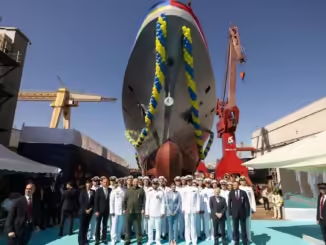
It will likely be at least another decade until Turkey can field a fifth-generation warplane. Until then, its options for acquiring a stopgap fighter for its air force are extremely limited.
Hellenic Air Force bought 18 French Dassault Rafale which will be delivered this year. Turkey left with aging F-16C/D, Turkey plans to upgrade F-16C to F-16V standard.
Turkey’s fighter jet fleet consists entirely of fourth-generation U.S.-built F-16C/D Fighting Falcons and older F-4 Phantom IIs. It began acquiring the former from the U.S. in the late 1980s and has license-produced copies of that iconic fighter jet.

But this fleet of jets is aging. By purchasing and taking delivery of S-400 air defense missile systems from Russia, Turkey got itself suspended from the fifth-generation F-35 Joint Strike Fighter program and had its order for at least 100 of these high-tech jets canceled by the United States.
There is no way Turkey can hope to acquire F-35s unless it removes all the S-400s it purchased from Russia, something it has shown absolutely no willingness to do.
Ankara says it’s building its own fifth-generation fighter, the TAI TF-X, but that won’t likely become operational until at least the 2030s.
In the meantime, the Turkish Air Force may well find itself in need of more advanced 4.5 generation jets as a stopgap to gradually replace Turkey’s older F-16s and F-4s.
This could well prove quite difficult for Turkey given its strained relations with the various countries that can sell it these type of jets.
Last year, Turkey contemplated buying either Russian 4++ generation Su-35s or Su-57s. The latter has not yet been produced in large numbers and will likely remain little more than a prototype for the foreseeable future.
If Turkey opts for Su-35s, that would strain its relations with the U.S. and the broader NATO alliance further and increase the risk of further U.S. sanctions. The same would be the case if Turkey seeks fighter jets from China.
Turning to the U.S., Washington’s frustration with the S-400 procurement likely means it won’t sell Ankara 4.5 generation jets anytime soon.
Given Turkey’s present rivalry with France, Paris will not likely sell it Dassault Rafales anytime soon, either. Turkey could opt for 32 Eurofighter Typhoons from the Italy given the aerospace ties both countries began forging after signing a $130 million deal in 2017 to develop the TF-X.

Turkey has hinted, on multiple occasions, that it would look to Russia,” for new fighter jets, said Aaron Stein, the Director of Research at the Foreign Policy Research Institute’s Middle East Program.
The Russians have said that there have been preliminary talks for the Su-35, but those talks do not appear to have ever been advanced, nor do they appear to be active at this moment.
Stein assumes that Ankara “is going to try and extend the life of some of its F-16s and try to wait for the TF-X before making a decision.
Analysts at BlueMelange, an Ankara-based independent research group which focuses on geopolitical developments on Turkey’s hinterland, see two different scenarios that could determine the future of the Turkish Air Force.
The first is one in which Joe Biden wins the U.S. presidential election and Turkish President Recep Tayyip Erdogan continues to lead Turkey with an “ultra-nationalist, imperialist and ultra-Islamic government.
In the second scenario, Biden also wins the election, but a new government is formed in Turkey without Erdogan. The analysts anticipate an early election in Turkey by around spring 2021.
In the first scenario, the BlueMelange team see no chance for the Turkish Air Force to sustain a modern fleet of fighter jets without Russian supplies.
Furthermore, in this scenario, they predict there will be no room for any Turkish partnership with the West since the “E.U., NATO, U.S., and U.S. allies all would apply many restrictions.
Such restrictions would include a ban on any potential sale of Rafales or Typhoons to Turkey so long as it remains engaged against the E.U. and NATO in the Eastern Mediterranean and Kurds in Syria or pushes ahead and activates its S-400s.
“This would mean Turkey is a carbon copy of Iran; isolated, lonely, marginal and looking to Russia,” they said.
If there is a Biden victory in November followed by the rise of a new non-Islamist Turkish government, the BlueMelange analysts anticipate “a chance for a great renaissance, reconciliation and re-approach between Turkey and the Atlantic.”
“Improving Western alignment means securing economic and military support for the modernization of Turkey’s NATO military,” they said.
Modernization, they suggested, could include upgrading Turkey’s F-16s to Block V configuration and selling Ankara an additional 32 new F-16Vs, which could significantly improve the ability and lifespan of its existing air force.

Also, in this scenario, the TF-X could become a more viable option for Turkey.
“The TF-X is also only available with the second option,” they said. “Without western assistance, support, know-how, NATO, and most importantly, funds and loans, it is impossible for Turkey to develop the TF-X in the 2030s.”
To summarize, Turkey has two choices in terms of a stopgap fighter aircraft until Turkey can build TFX fighter, Turkey can buy 32 F-16V Block 70 from the U.S. or 32 Eurofighter Typhoon Tranche 4 from Italy.
© 2021, GDC. © GDC and www.globaldefensecorp.com. Unauthorized use and/or duplication of this material without express and written permission from this site’s author and/or owner is strictly prohibited. Excerpts and links may be used, provided that full and clear credit is given to www.globaldefensecorp.com with appropriate and specific direction to the original content.






Be the first to comment